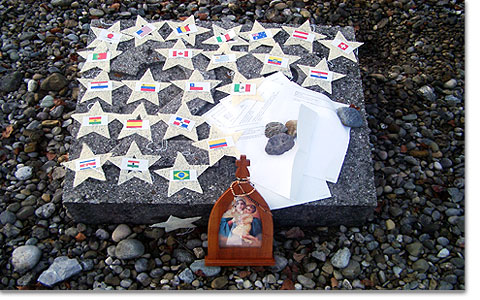
|
| Llevaron las “Estrellas” de las naciones a Dachau: que cada Dachau de esa tierra sea tocado por las gracias del Santuario Bringing the “stars” of the nations to Dacha: may each Dacha of this world be touched by the graces from the Shrine Die “Sterne” der Nationen in Dachau: dass jedes Dachau dieser Welt von den Gnaden des Heiligtums berührt werde |
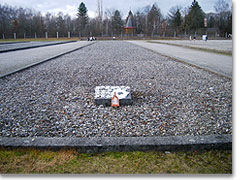 |
|
Bloque 26 Block 26 Block 26 |
|
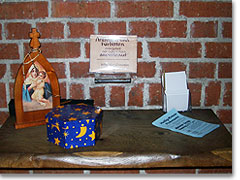 |
|
En la capilla del Carmelo In the Carmel chapel In der Karmelkapelle |
|
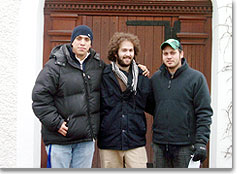 |
|
Los tres voluntarios The three volunteers Die drei Voluntäre |
|
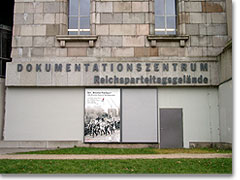 |
|
En Nuremberg In Nürnberg In Nürnberg |
|
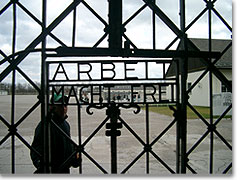 |
|
Descubrir Dachau como lugar de gracias Discovering Dacha as a place of grace Dachau als Gnadenort entdecken Fotos: T. Garzón de la Roza © 2007 |
|
SCHOENSTATT, Tomás Garzón. Everything is ready for the departure. The auto has gasoline, the suitcases are prepared and the maps of the route are printed. Before departing, we gathered the stars that represent the intentions of many people from around the world that were deposited for Christmas from Father Kentenich’s tomb. The Pilgrim MTA is also going on our passionate itinerary. However, some problems of navigation doubled the time of the trip to Wurzburg, the first stop. "It is part of the adventure", Guillermo, a volunteer of the Schoenstatt-Summer House and a member of the Boys’ Youth from Monterrey, Mexico, calmly assured. The following day, after a hearty breakfast, the real trip through the history of Europe, Germany, and of Schoenstatt began.
Since the beginning we knew that the proposal to go on pilgrimage from Schoenstatt to Dachau was very special. At the same time, it is difficult to be aware of the experiences with which life confronts each of us in an instantaneous manner. That is why we arrived to Reichsprteitagsgelande (The Convention Center of the Party) of the city of Nuremberg as if arriving at just any building, However, after some minutes of traveling through the center of documentation of this building which represents the German National Socialist Party – one of the few that are still standing – was enough to begin to feel the weight of history. Arno Hernadi, a seminarian of the Schoenstatt Fathers, constantly reminded us that those years definitely marked the life of Father Kentenich, and therefore, and also that of the Schoenstatt Family.
I asked myself: How was it possible that all this happened? Is there any logic, or some kind of explanation for such a history" This restlessness within me accompanied me as well as in my travel companions throughout the weekend. Meanwhile, it was time to continue, since there was still a long way to go before arriving at our final destination, Dachau. We had the desire to bring the intentions of many Schoenstatters to this place. To do this, we had to reflect profoundly in order to understand what Dachau meant for our founder.
History becomes a reality
Our first journey in the model concentration camp went from silence to reflection. The murmurs among the visitors from many parts of the world were barely heard. When we arrived to the room of remembrance and of gratitude, we discovered that the story was true. Yes, Father Kentenich, the same priest that proposed to a group of youth to make a small chapel a place of pilgrimage, was also at the mercy of this ill fated reality.. Poncho, Guillermo’s companion in the Mexican youth, pointed to the photo of Karl Leisner with timid enthusiasm. "He belonged to Schoenstatt, didn’t he?", he asked us, seeking confirmation. Some hours later, below an appropriate gray sky, we finished the first complete tour through Dachau.
In reality, the following morning was the time to follow the footsteps of Joseph Kentenich at this place. The sites were the same, but this time, the focus was different. In order to do this it was necessary to go back in time to the beginning of the Second World War. Arno explained that Father Kentenich, in his constant clarity, knew what awaited him. And eventually he accepted that it was destined for him and the family, and on that 20th of January 1942, through secret letters he asked them to please understand this.
Mission accomplished
Religious pilgrimages usually end in a great spiritual centers or Marian shrines. So, for us, it was difficult to imagine where our stars and personal intentions would remain. While we heard different anecdotes about the secret letters between Father and the Sisters of Mary, and about his encounters with the SS, we arrived to the place where barrack 26 had been. Father Kentenich had lived in it during almost all his stay in Dachau. Then, it was clear for us: this was the right place for our stars, because this was the place where he spent his life, where he experienced the anguish and desires of all the Schoenstatt Family. "Are you digging a hole for the stars", I asked Arno with surprise. Then, we deposited them and departed toward the Carmelite Monastery that adjoins the concentration camp. We decided to entrust them with the special intentions that we carried.
We carried many ideas and reflections in our small blue box that should illuminate us from now on in our personal road. Now we have had a closer look of how to build a fuller life from this unusual and desperate place.
Novena for the 20th of January
The novena of preparation for another anniversary of the 20th begins. Father Mariano Irureta, Provincial of the Schoenstatt Fathers in Chile offers all the Schoenstatt Family a Novena with nine main topics about what is known as the second milestone in the Schoenstatt history: Faith in the supernatural reality, faith in the reality of the Covenant of Love, conquering inner freedom, the indissoluble solidarity of destinies with the head of the family, the indissoluble solidarity of destinies among the members, the Blank Cheque, Inscriptio. "The chains have fallen", mission consciousness.
The first edition of 3,000 copies (in Spanish), published by Editorial Patris Argentina and Editorial Patris Spain, is available in the Schoenstatt bookstores or via: editorial-patris-argentina@schoenstatt.org.ar
Translation: Celina Garza, Harlingen, USA